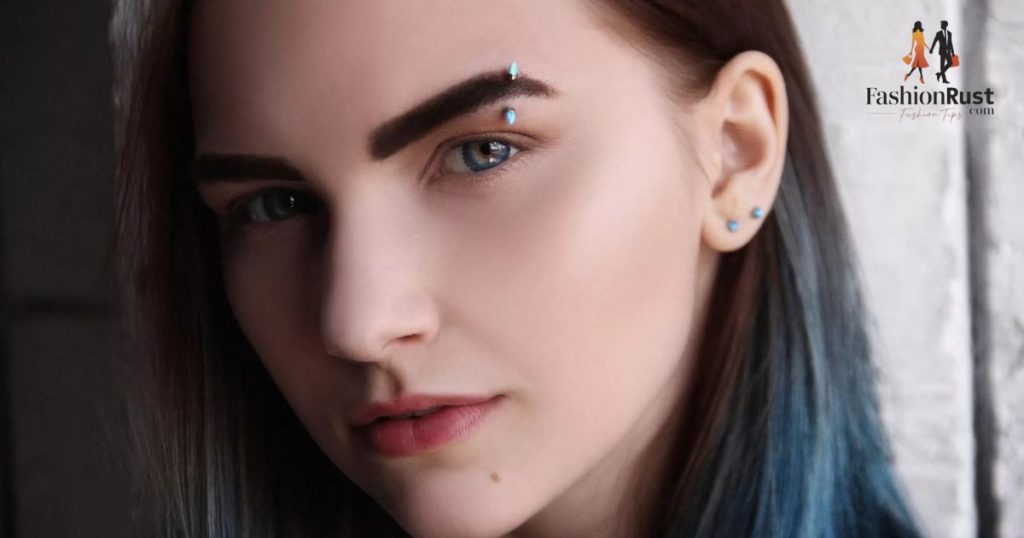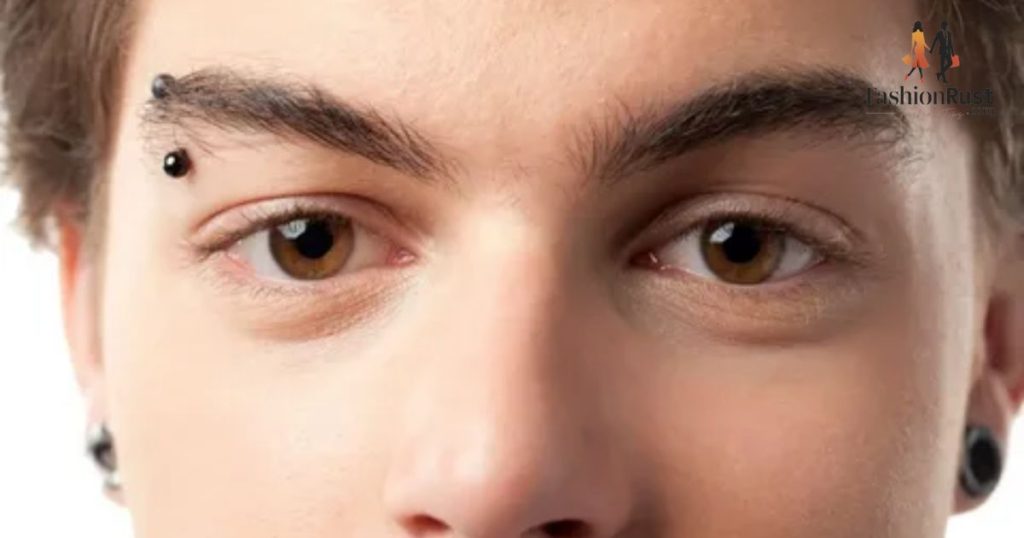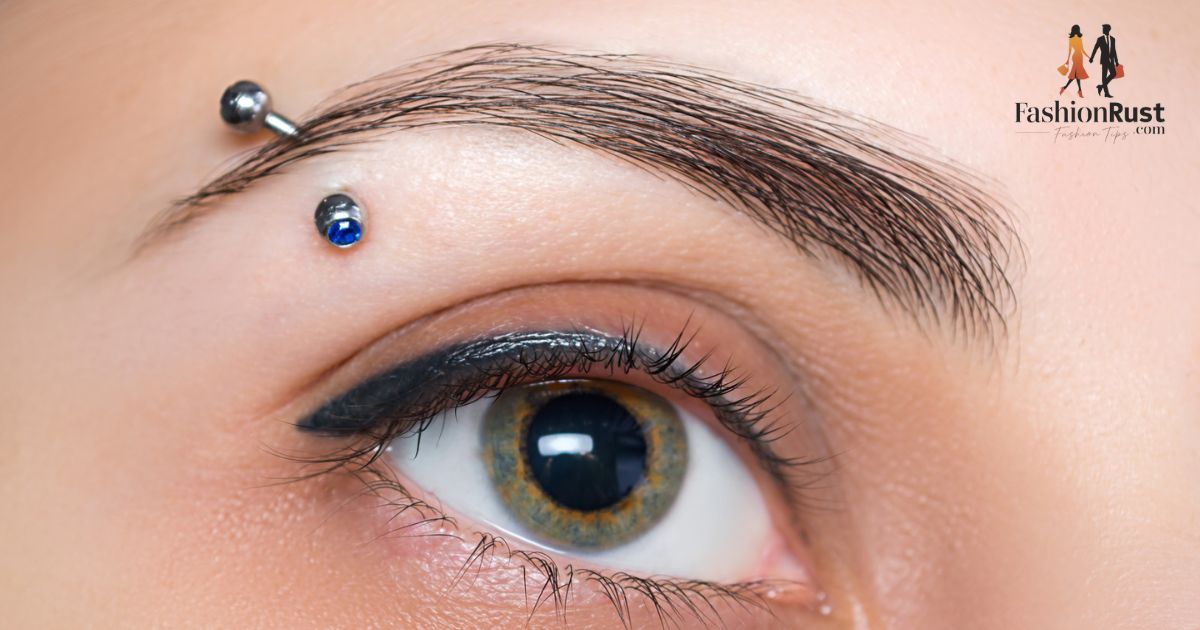An anti-eyebrow piercing is a facial piercing that goes below your eyebrow, near your cheekbone. It’s not in the eyebrow itself like a normal eyebrow piercing. Because of where it’s placed, it gives a unique and unusual look compared to more common piercings. This piercing makes a statement and shows off your quirky personality.
In this article, we will cover everything you need to know about anti-eyebrow piercings. We’ll explain exactly where it goes and what the piercing process involves. You’ll also learn tips for choosing jewelry and caring for your new piercing.
What is an Anti-Eyebrow Piercing?
Unlike a normal eyebrow piercing that pierces through the brow, an anti-eyebrow piercing pierces the skin just under the hairline instead. This makes it more unconventional and stands out from traditional eyebrow piercings.
It creates an eye-catching aesthetic and edgy vibe. An anti-eyebrow piercing is perfect for people who want to make a bold statement with their looks and display their rebellious side through body art.
The Procedure: Pain and Gain
The procedure “Pain and Gain” involves manipulating muscles to relieve pain and improve mobility.
Warm Up
The therapist will have the client perform light stretches and range of motion exercises to warm up the muscles and joints. This increases blood flow and prepares the body for more profound work.
Soft Tissue Work
Using techniques like massage, myofascial release, and trigger point therapy, the therapist will work out knots and adhesions in the muscles. This helps relieve tension and pain held in the soft tissues.
Active Isolated Stretching
Specific muscle groups are stretched while in a contracted state. This allows the muscle to lengthen without compromising the joint. It helps improve flexibility.
Stretching
Gentle static and dynamic stretches are used further to increase the range of motion in the joints. The goal is to restore flexibility without causing pain.
Read More About: Surface Tragus Piercing 101: The New Statement in Body Art
Cool Down
The session ends with some relaxing stretches and isometric contractions of the muscles. This allows the body to transition slowly and prevent dizziness or headaches from rising too quickly. Proper warm-up and cool-down bookend the more profound therapeutic work done at the core of the session.
Choosing the Right Jewelry

There are several factors to consider when choosing the right jewelry for an occasion or outfit. The style, color, and size of the piece should complement one’s features, complexion, and overall look.
In the daytime, smaller and simpler styles often work best so as not to overpower an outfit. At night, bolder and darker colored jewels can make a statement. The material should also fit the event, with gold, silver, or platinum best for dressier affairs and alternative metals like stainless steel more suitable for casual wear.
Just as important as what you wear is where you wear it – some pieces look best as a sole statement piece, while others can be layered or paired with other jewels. Choosing flattering and appropriately stylish jewelry takes some evaluation of what accentuates personal traits and fits the lifestyle.
Aftercare Tips for a Happy Piercing

- Clean the piercing 2-3 times daily with a sterile saline solution spray. Avoid touching or moving the jewelry unnecessarily.
- Rinse well in the shower without spraying directly onto the piercing. Use only water, and do not use soaps that can irritate.
- Allow the piercing to fully dry before getting dressed. Moist environments encourage bacteria.
- Downsize the jewelry when recommended by your piercer to prevent irritation from overly long jewelry moving around.
- Avoid submerging the piercing fully in water like pools/baths for six weeks to prevent bacteria.
- Consider using sterile saline-soaked gauze pads instead of direct spraying if the piercing is sensitive.
- Massage with saline 2x a day once fully healed to prevent scar tissue buildup.
FAQs
How long does a piercing take to heal?
For most piercings like earlobes, the initial healing time is 3-6 months. Cartilage or facial piercings may take 6-12 months to heal as the area is more dense entirely.
Is there pain after getting a piercing?
Most people feel some slight soreness or tenderness for a few days after getting pierced. Taking an over-the-counter pain reliever can help with any discomfort.
When can I change my piercing jewelry?
You should wait at least six months after getting pierced before changing your jewelry. This allows time for the puncture holes to stabilize inside your skin.
Can I use antibiotics on a new piercing?
Topical antibiotic creams or ointments are generally not recommended for new piercings. Stick to sterile saline cleaning instead, which will not dry out the piercing or irritate healing skin. Prescription antibiotics may be necessary if an infection occurs.
Final Thoughts
Following the proper aftercare routine and allowing adequate time for healing is vital to ensuring a happy and healthy piercing. While it can be tempting to change jewelry styles early or forget about cleaning, taking care of the piercing during the initial months is important.
For any issues like persistent swelling, tenderness, or discharge during healing, consult your piercer right away. An infection is much easier to deal with at an early stage. With time and care, you will be able to enjoy your piercing as a meaningful accessory fully. Committing to proper care, especially in the beginning, means many years of trouble-free wear ahead to showcase your style through body art.

I love fashion. I’ve been writing on fashion for over 10 years now. Style is my passion so I’m excited to share what I create on my website.











